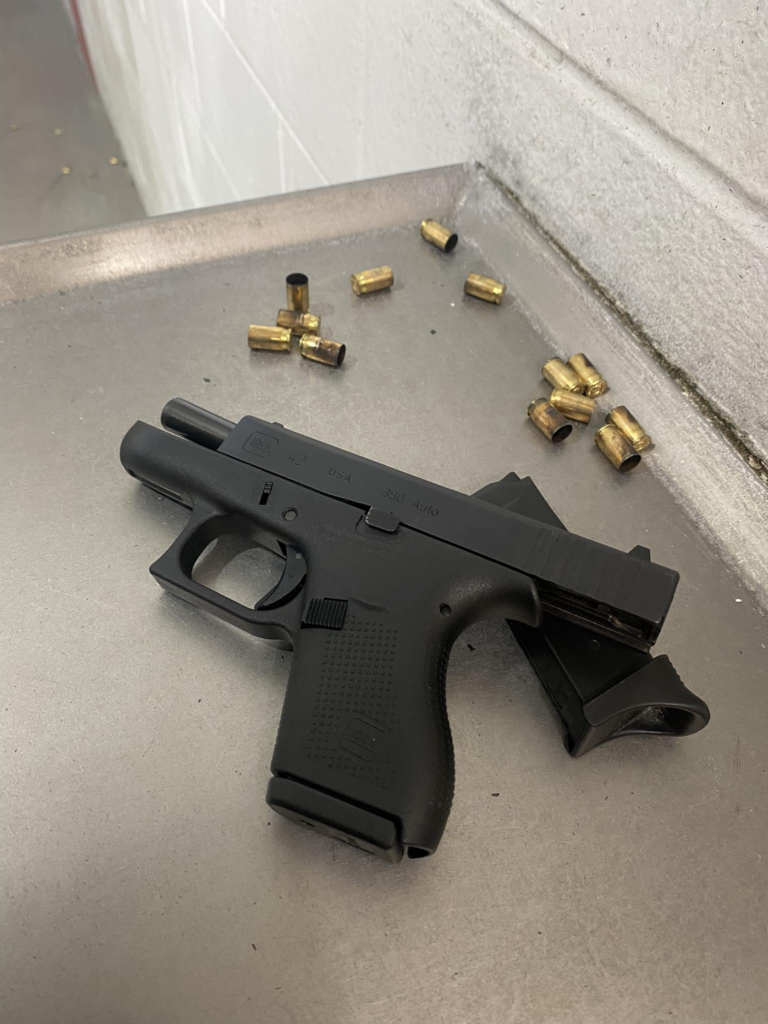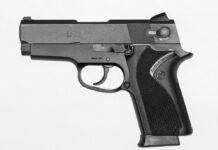The .380 ACP Glock 42 first entered the scene a decade ago, after its reveal at SHOT Show 2014. Besides being the smallest Glock pistol ever fielded, this tiny pocket rocket is unique for two main reasons. First, due to arbitrary gun control and import restrictions set up around handgun calibers, the Glock 42 is wholly American-made. Second, unlike Glock’s other .380 ACPs, the Glock 42 is designed with a standard Browning delayed recoil blowback system. Even the other two .380 ACP models in Glock’s portfolio make use of a modified version of straight blowback (Glocks 25 and 28). By including the same mechanism in the Glock 42 of its larger siblings, the end result is a micro-compact handgun that’s surprisingly smooth shooting for its size.
Glock 42: Overview

As a product of the mid-2010s, the Glock 42 bears all the typical stylistic functions of the fourth generation models save for the finger-grooves. Its grip is covered in the squared dot texture that first appeared on the fourth generation and still found on the fifth generation. The muzzle end of the slide is squared off and hog-nosed, as the chamfering of that part wasn’t standard across all models like it is for the fifth-generation.
Like already mentioned above, the .380 ACP Glock 42 is a perfectly miniature model of the typical full size 9mm versions. It even has the same dual captured recoil springs and the same standard factory Glock rectangle and dot front and rear sights. In short, other than the frame and parts being scaled down for size, there’s nothing otherwise remarkable or outstanding in the Glock 42. It’s a Glock, like any other. Not surprisingly this also means that the stock trigger isn’t anything to brag about. Although the pistol is reliable and uses Glock’s more-than-proven action, I found that in the case of this smaller pistol, it’s more sensitive to the elements, carbon and fouling so shooters would do well to keep an eye on it a little more often than they would for their normal Glock.
Until I bought mine, I was always under the assumption that the Glock 42 and the 9mm Glock 43 were the same size, but the Glock 42 happens to be slightly smaller. Its form factor is amongst the best in its class as a micro-compact defensive pistol. Besides the back of the slide, there’s not much that the Glock 42 can snag on. Unfortunately, this pistol, like all the other “slimline” guns lacks an ambidextrous slide-stop. Due to its size, overall low capacity and mission, the lack of the ambi slide-stop isn’t critical as the gun wasn’t designed for speed-reloading either.
Glock 42’s Niche
Because of its small size, low capacity and marginally viable caliber, this pistol is nothing more than a back-up gun (BUG) or a minimalistic carry piece. In this sense its greatest weakness is also its greatest strength. After all, a fully loaded Glock 42 with 7 rounds only weighs 460 grams (16.2 oz)– just slightly over a pound. Strictly in this sense, the 42 is comparable to a 2” snub-nose revolver. A savvy north Texas street-cop was the first person to put the Glock 42 in my radar. Similarly, I had a chance to speak with legendary lawman Chuck Haggard who also disclosed his great love for this little pocket rocket. To date, he’s fired thousands of rounds of .380 ACP through his Glock 42 and can clean the Kansas law enforcement qualification shooting this gun with a perfect score.
I wouldn’t be the first or only person to wonder how this Glock compares to the typical .38-caliber snub revolver, given their overall similar size and payload capacity. Haggard is arguably one of the foremost experts on the use and employment for both small pocket semis and snub-nosed revolvers. Whether one is better than the other, he’d probably tell you that it depends on each situation, use-case, manner of dress, etc. Its small form factor allows for many forms of BUG carry: on the waistband, ankle, pockets, police vests and even deep concealment. Carry style and positioning possibilities is the area where this small and otherwise “marginal” pistol gives its carrier the most flexibility.
Practical Accuracy & The .380 ACP
Shooting-wise, this little pistol is mild and pleasant to shoot. I had no prior experience with this ancient cartridge and my first impression was that it truly did feel like a “diet 9mm.” And practically speaking, it is 9mm-lite. From a precision standpoint the Glock 42 isn’t hard to shoot. But it’s also not easy, especially with the stock trigger and stock sights.
That said, I shot two separate types of .380 ACP carry ammo at 10 yards. These cartridges include Federal Premium’s 99-grain Personal Defense HydraShok Deep JHP (P380HSD1) and Sierra’s Sport Master 90-grain JHPs. Besides, the only other rounds I’ve put through mine has been basic ball ammo, like CCI Blazer 95-grain FMJs. The HydraShok Deep is loaded to offer 12-inches of penetration. Even from this marginal chambering, so it feels warmer than the Blazer or Sierra rounds. That said, it’s snappiness is nowhere near that of a .38-caliber snub revolver. From a pure accuracy perspective, the gun is capable of providing plenty of mechanical accuracy… But the biggest limiting factors are going to be the stock trigger and stock sights. Fortunately, finding upgraded sights isn’t too difficult. Is this easier to shoot than most snubs? By far!

Glock 42: The Takeaway
In many ways a Glock is a Glock is a Glock. But in the case of the Glock 42, this diminutive .380 ACP single-stack pocket pistol happens to punch above its weight given its bases on Glock’s proven tilting barrel delayed blowback action. The standard plastic Glock sights (aka “Dovetail Protectors”) can easily be swapped out with any other aftermarket units that are slimline compatible. While the trigger isn’t anything special, I actually think its best left alone on this micro-compact defensive firearm. In fact, I’ve noticed that when handling it or drawing it, one has to be careful not to muzzle their hands, as it’s not hard for this tiny gun to disappear in the palm. I bought my gun used and the magazine it came with included an aftermarket finger ledge, and I take full advantage of that feature while shooting.
Even a decade later, the Glock 42 is still be found in gun shops big and small or outdoor big-box stores prominently besides all current or newest models. Like the ancient cartridge it’s chambered for, this Glock isn’t going anywhere any time soon.




